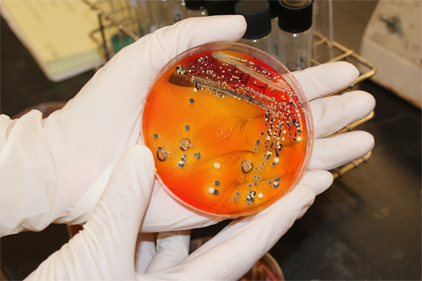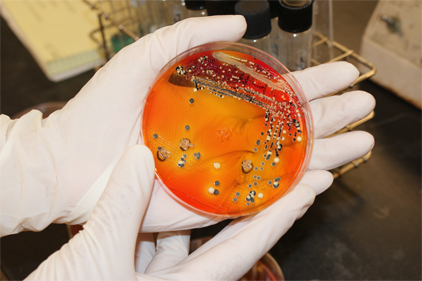
With FSMA setting regulations for food safety in plants and GFSI schemes becoming part of the auditing requirements customers want to see, environmental and compressed air quality in plants has become critical.
Food Engineering asked Shari Spector, regional marketing of EMD Millipore’s BioMonitoring group, what processors can do to determine if they have environmental and compressed air problems and what steps they can take to fix them.
Food Engineering: Architectural and engineering firms have been doing their best to design new structures that move air throughout the plant from the cleanest (processing) areas to the dirtiest (storage and loading docks). But, in many cases processors have unknowingly altered airflow by making subtle changes in their plants, and some processors are saddled with old buildings that were not designed with airflows in mind at all. What types of instrumentation are available to let processors check the cleanliness of air (especially microbiological) in their processing environments?
Spector: Active air monitoring equipment captures organisms on agar, allowing them to grow so that colonies can be counted. Most air monitors are designed for general environmental monitoring, but the choice of technology may vary depending on user requirements. Accurate monitoring of compressed gas requires either specialized air monitoring equipment or special attachments for general air monitors, for example, the RCS high-flow touch microbial air sampler with the RCS compressed gas attachment. Particle counters measure total particles including not only viable and non-viable microorganisms, but also dust and other particulates.
Food Engineering: Can processors operate this equipment and interpret the results easily? Can these devices measure airborne bacteria, viruses, particulates, chemicals, etc.?
Spector: Measurement equipment is designed for ease of use, and anyone in the manufacturing plant can be trained to use the instruments to acquire samples. Our particle monitoring systems output pass/fail data, based on user specifications. Analyzing bacterial, yeast and mold counts is as simple as counting colonies that grow on agar media and comparing the numbers against the plant’s specification. Viruses and most chemicals are too small to be detected by particle counters.

|
| Shari Spector, regional marketing of EMD Millipore’s BioMonitoring group. |
Food Engineering: Does FDA or USDA have any specific numbers of what bacteria levels may be present in various processing stages in a plant?
Spector: FSMA includes rules for preventative controls, but does not specify which controls are required. HACCP [Hazard Analysis and Critical Control Point] rules outlined in the Code of Federal Regulations, 21 CFR part 120, describe the need for monitoring any point in the process at which food may become contaminated, but there is no specific mention of air or compressed air monitoring. Specific requirements for air monitoring come only from private accreditation institutions such as ISO [International Organization for Standardization] and SQF [Safe Quality Food], but even these organizations do not say what to test or how frequently. Limits on bacteria levels are not specified in the regulations; instead, alert and action levels may be established based on the criteria in the HACCP plan. If these levels are exceeded, an investigation to determine risk to the final product and root cause should be conducted.
Food Engineering: What are the limitations of air sampling equipment?
Spector: Air monitoring equipment that captures organisms on agar only detect bacteria that grow on that particular medium. Thus, detection is limited to culturable bacteria, yeasts and molds. Some gases, such as nitrogen, may harbor anaerobes, in which case specialized media and incubation conditions must be implemented. In addition, viruses such as Norovirus cannot be detected. Particle counting does not distinguish between viable and non-viable particles, but can detect and quantify all particulates such as dusts, aerosol droplets and any bacteria, yeast or mold within the size limits of the instrumentation.
Food Engineering: Where and how often do processors need to conduct tests and accumulate data before taking action to fix environmental air that may be contaminated?
Spector: The rules requiring air monitoring are not specific, so there are no particular requirements for frequency or location of testing. Processors must make those decisions during the risk assessments in their HACCP plans. Generally, any contamination found in compressed gas lines is grounds for an investigation.
Food Engineering: Air compressors are often located in the dirtiest areas of a plant, yet this air often comes in contact with food surfaces and/or food itself. What recommendations do you make in cleaning compressed air so it’s free of bacteria, lubricants and other chemicals? What about the level of moisture in compressed air?
Spector: Good system design and preventative maintenance are critical to minimize moisture in compressed air and ensure it is free of bacteria, lubricants and oils. It is typically the responsibility of facilities engineers to design these systems, so they need to be trained in microbial risk or consult with microbiologists during the design.
Food Engineering: Compressed air in most food plants falls into the 75 - 100 psi range. What equipment can be used to sample this air? How often should tests be done to check bacterial levels (assuming filters and piping accumulate bacteria)?
Spector: Air monitoring equipment for testing compressed air must be able to withstand the air pressure. Traditional methods, utilizing membrane filtration, must have a bypass mechanism to adjust the incoming pressure of the gas to not rupture the membrane. To eliminate this additional, time-consuming step, specialized air monitoring equipment such as the MAS-100 CG EX or a conventional air monitor with a special attachment, for example, the RCS high-flow touch microbial air sampler with the RCS compressed gas attachment, can be utilized. Particle counters also require special attachments for compressed gas testing and can be a valuable tool to trend particulate matter in the piping that could potentially carry microorganisms, and to detect other particulates that should not be present, such as water droplets or oil.
Food Engineering: Compressed air systems in plants may have thousands of feet of piping. At what stages should the compressed air quality be checked?
Spector: Compressed air quality should be checked at each point of use. This will give the best indication of the impact of air quality on the final product. The end of the loop for the compressed gas system should also be checked to verify the gas passing through the entire system is clean.
Food Engineering: If a processor finds an unsuitable level of bacteria in compressed air, what needs to happen to remediate the problem?
Spector: The source of contamination needs to be identified and eliminated via cleaning and sanitization at the source and throughout the entire downstream system. An investigation should commence to determine the root cause and to assess the impact on the final product. The results of the investigation should yield preventative and corrective actions to mitigate future risks.
Food Engineering: How often should compressed air be checked? Should the frequency of tests be scheduled based on change-out of filters?
Spector: The industry standard for frequency of compressed gas sampling is typically once per quarter. However, this frequency may be affected by the results of the HACCP plan if some points of use are more critical to the quality of the finished product than others. If the risk of microbial, particulate or chemical contamination increases when system filters are changed, then these time points should be added to the sampling plan.
Food Engineering: What other important issues regarding the measurement of environmental air quality and/or compressed air quality are important?
Spector: In choosing air monitoring equipment, the time and resources required for sampling must also be considered. Depending on the type of equipment being used and the sensitivity of the instrument to capture accurate results, sample times may vary. In addition to monitoring air quality, it is also important to maintain air monitoring equipment with routine preventative maintenance and calibration services.
For more information, visit EMD Millipore online.




